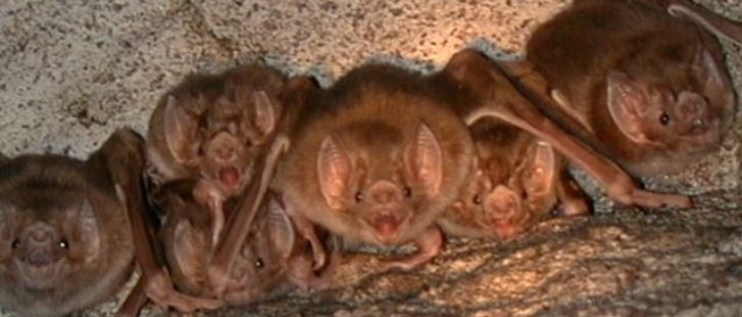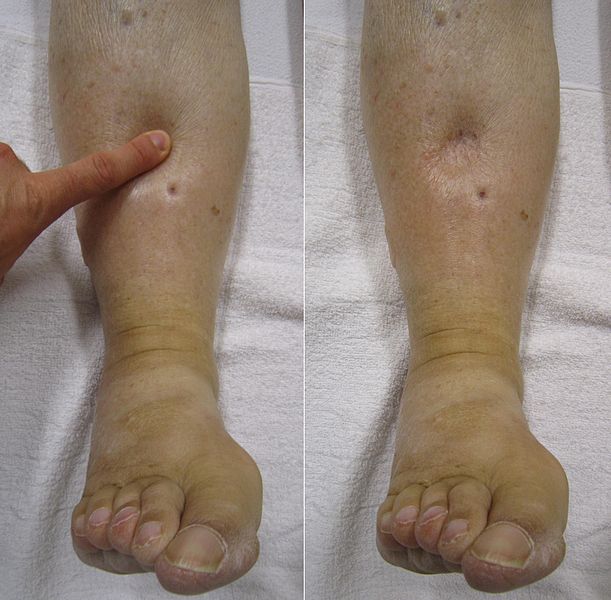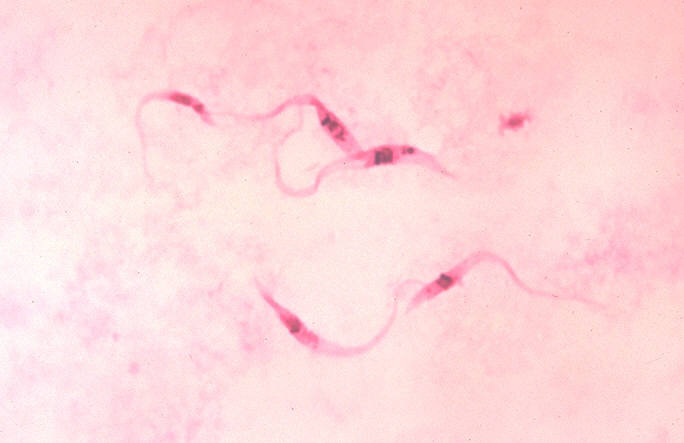
Interactions
Within ecosystems, the common vampire bat is very much so a predator and even a pest to some. The vampire bat is a mammal that many farmers dread. Desmodus rotundus attacks many common domestic animals such as: cows, horses, pigs, sheep, and goats during the night hours usually leaving the animal and its caretaker unaware.

Vampire bats are known the
transmit diseases in livestock throughout their geographical region
but this bat species is not foreign to contracting diseases from
livestock. Some domestic mammals that Desmodus rotundus
enjoys to take blood from such as horses, sometimes carry their
own diseases. One disease that has been known to run rampant in
many horse and livestock species is "murrina." Murrina is a trypanosomiasis
disease which means
it is a disease caused by a small parasitic protozoan
(Darling 1911). This tiny parasite causes edema (swelling due
to fluid build up from body tissues)
 and
weakness in horses and livstock (Darling 1911). The photo to the
right is of edema in human legs but is similar to what is seen in
other mammals. Many horse and
livestock owners do not
notice an infected animal immediately and sometimes notice too late.
Over time the animal will slowly deteriorate and become weak due to
the parasite growing rampant in numbers within the animal's blood
stream.
and
weakness in horses and livstock (Darling 1911). The photo to the
right is of edema in human legs but is similar to what is seen in
other mammals. Many horse and
livestock owners do not
notice an infected animal immediately and sometimes notice too late.
Over time the animal will slowly deteriorate and become weak due to
the parasite growing rampant in numbers within the animal's blood
stream.
 When
a vampire bat comes to feed he does not see an infected animal, he just sees dinner. The bat will go on with its usual routine and
lap up blood from the animal. The vampire bat will finish feeding
presumably
satisfied and return to its roosting spot. Back at its roost, the bat
may help prevent a fellow roost member from starving by
regurgitating
some of its dinner. Regurgitating can then infect that roost member as well.
As you can see, this can turn in to quite the domino effect. Murrina in equines and livestock is lethal to vampire bats
and vicious to vampire bat roosts. Murrina has been documented to
kill corrals of horses and livestock but also
roosts of vampire bats in Central America, more specifically,the Panama Canal region
(Darling 1911).The below map (courtesy of wikipedia.org) highlights the areas where trypanosome
diseases are most common. Trypanosomiasis diseases in horses and
livestock can be treated with different medications if caught early
enough. Although treatments do exist, many animals in high risk
areas (those highlighted on the map below) are becoming immune. Due
to this immunity, trypanosomiasis diseases are becoming more common
and less treatable (wikipedia.org). If you do not own cattle or
other livestock you may think trypanosome diseases do not
matter for the human population but the truth is, these diseases can also be spread to humans via
the tsetse fly! When trypanosomes advance in humans they attack the
nervous system and if left untreated, death is consequential!
When
a vampire bat comes to feed he does not see an infected animal, he just sees dinner. The bat will go on with its usual routine and
lap up blood from the animal. The vampire bat will finish feeding
presumably
satisfied and return to its roosting spot. Back at its roost, the bat
may help prevent a fellow roost member from starving by
regurgitating
some of its dinner. Regurgitating can then infect that roost member as well.
As you can see, this can turn in to quite the domino effect. Murrina in equines and livestock is lethal to vampire bats
and vicious to vampire bat roosts. Murrina has been documented to
kill corrals of horses and livestock but also
roosts of vampire bats in Central America, more specifically,the Panama Canal region
(Darling 1911).The below map (courtesy of wikipedia.org) highlights the areas where trypanosome
diseases are most common. Trypanosomiasis diseases in horses and
livestock can be treated with different medications if caught early
enough. Although treatments do exist, many animals in high risk
areas (those highlighted on the map below) are becoming immune. Due
to this immunity, trypanosomiasis diseases are becoming more common
and less treatable (wikipedia.org). If you do not own cattle or
other livestock you may think trypanosome diseases do not
matter for the human population but the truth is, these diseases can also be spread to humans via
the tsetse fly! When trypanosomes advance in humans they attack the
nervous system and if left untreated, death is consequential!
Many humans have a fear of being bitten by vampire bats. Is it possible? Yes, but it is very uncommon. The relationship humans have with the common vampire bat may soon become more symbiotic than it has ever been. The anticoagulant bats posses in their saliva is currently under research by many different institutes. The anticoagulant within bat saliva deemed "draculin" may be very useful in those who suffer from heart attacks, strokes, and other blood clot disorders. With strokes and heart attacks being very common deaths for humans, the vampire bat's saliva could be life changing for some individuals. The proteins that bats use to make up the anticoagulant are thought to be up to 20 times stronger than any anti clotting medication on the market to date (Belwood 1991). The proteins in the saliva and other anticoagulants work to bust the netting components of blood clots. Research into bat saliva is recent and on going but currently research shows that there are fewer side effects seen in patients using desmoteplase, an anticoagulant drug stemmed from bat saliva, than other drugs on the market (Belwood 1991). The current test drug at The Ohio State University, desmoteplase, has been documented to help stroke victims dissolve blood clots for up to nine hours after a stroke (medicalcenter.osu.edu). With more research, the vampire bat could be more respected and appreciated by the human population. For more information on what researchers are currently doing in Ohio, check out this video.
Although the common vampire bat is a very good predator to many, it is still dinner for others. Desmodus rotundus is often hunted by eagles, hawks, and humans (a-z-animals.com). Many humans do not kill vampire bats to eat for dinner but instead to save their livestock. As stated above, farmers fear the wrath the vampire bat's bite can have on their precious animals. Even though humans kill Desmodus rotundus to save their livestock, humans have been afraid of the common vampire bat for decades. The bat's role in popular culture has given it quite the reputation. To read about how bats are portrayed to many young children click here. For interesting yet scary stories of human encounters with Desmodus rotundus check out these two videos 1. 2.
